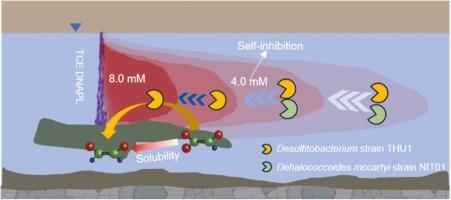含脱硫菌群落对接近饱和浓度的三氯乙烯的还原脱氯
IF 11.3
1区 环境科学与生态学
Q1 ENGINEERING, ENVIRONMENTAL
引用次数: 0
摘要
在致密非水相液体(DNAPL)污染源区,地下水中三氯乙烯(TCE)的水浓度可能接近饱和水平(8.4 mM)。一般认为,这样的饱和浓度对有机盐呼吸细菌(OHRB)是有毒的,从而限制了生物修复的有效性。在这里,我们描述了一种含有脱硫菌的培养物,能够在高达8.0 mM的水浓度下将TCE脱氯为顺式二氯乙烯(cis-DCE)。通过16S rRNA基因靶向聚合酶链反应和Illumina MiSeq测序,鉴定了一种新的脱硫菌群,命名为菌株THU1。微生物群落分析表明,4.6 mM以上TCE浓度对微生物群落组成有显著影响,但对Shannon指数影响不大。菌株THU1的基因组显示两个还原脱卤酶(RdhA), RdhA2可能是一个pceA。此外,其基因组编码参与应激反应和调控途径的蛋白质,使其能够耐受接近饱和的TCE浓度。我们的研究结果提供了对Desulfitobacterium的代谢灵活性的见解,表明它可能作为源区生物修复的候选物,通过增加DNAPL-水界面的浓度梯度来增强TCE DNAPL的溶解。本文章由计算机程序翻译,如有差异,请以英文原文为准。

Reductive dechlorination of trichloroethene at concentrations approaching saturation by a Desulfitobacterium-containing community
In dense nonaqueous phase liquid (DNAPL) contaminant source zones, aqueous concentrations of trichloroethene (TCE) in groundwater may approach saturation levels (8.4 mM). It is generally believed that such saturation concentrations are toxic to organohalide-respiring bacteria (OHRB), thus limiting the effectiveness of bioremediation. Here, we describe a Desulfitobacterium-containing culture capable of dechlorinating TCE to cis-dichloroethene (cis-DCE) at aqueous concentrations as high as 8.0 mM. A novel Desulfitobacterium population, designated as strain THU1, was identified by the 16S rRNA gene-targeted polymerase chain reaction and Illumina MiSeq sequencing. Microbial community analysis revealed that TCE concentrations above 4.6 mM significantly affected the composition of the microbial community but had little effect on the Shannon index. The genome of strain THU1 revealed two reductive dehalogenases (RdhA), and the RdhA2 is a putative pceA. Additionally, its genome encodes proteins involved in stress response and regulatory pathways, enabling tolerance to near-saturation TCE concentrations. Our findings provide insights into the metabolic flexibility of Desulfitobacterium, suggesting its potential use as a candidate for source zone bioremediation to enhance the dissolution of TCE DNAPL by increasing the concentration gradient at the DNAPL-water interface.
求助全文
通过发布文献求助,成功后即可免费获取论文全文。
去求助
来源期刊

Journal of Hazardous Materials
工程技术-工程:环境
CiteScore
25.40
自引率
5.90%
发文量
3059
审稿时长
58 days
期刊介绍:
The Journal of Hazardous Materials serves as a global platform for promoting cutting-edge research in the field of Environmental Science and Engineering. Our publication features a wide range of articles, including full-length research papers, review articles, and perspectives, with the aim of enhancing our understanding of the dangers and risks associated with various materials concerning public health and the environment. It is important to note that the term "environmental contaminants" refers specifically to substances that pose hazardous effects through contamination, while excluding those that do not have such impacts on the environment or human health. Moreover, we emphasize the distinction between wastes and hazardous materials in order to provide further clarity on the scope of the journal. We have a keen interest in exploring specific compounds and microbial agents that have adverse effects on the environment.
 求助内容:
求助内容: 应助结果提醒方式:
应助结果提醒方式:


